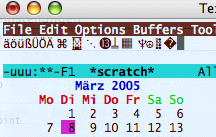[Top][All Lists]
[Date Prev][Date Next][Thread Prev][Thread Next][Date Index][Thread Index]
Re: Coding systems and Terminal.app on Mac OS X
|
From: |
Peter Dyballa |
|
Subject: |
Re: Coding systems and Terminal.app on Mac OS X |
|
Date: |
Fri, 25 Mar 2005 00:34:55 +0100 |
Hello!
Terminal.app is a complicated application and clearly not finished
(with ls in Terminal I can't see UTF-8 file names correctly, only
a??o??u????U??O??A?????, doing it in Emacs' shell I see
a\314?o\314?u\314?\303?U\314?O\314?A\314?\342?\254 and in dired as the
correct string äöüßÜÖÄ€ as in Finder too).
Maybe we should try to adjust our settings. I have in Terminal's
«Window Preferences»
in *Emulation* set
Option+Click to position cursor in command line
(non-ASCII -> Esc is not active/checked)
in *Monitor* set
Lucida Sans Typewriter Regular (a font from the Java Runtime
Environment)
anti-aliasing
Copy&Paste with moving/dragging
UTF-8 encoding
in *Keyboard* /not/ set
alt/Option/⌥ as Meta//Command/⌘
Am 24.03.2005 um 18:17 schrieb Stefan:
TERM_PROGRAM=Apple_Terminal
TERM_PROGRAM_VERSION=100.1.4
Now, the next problem is keyboard input: my meta key doesn't work in
Terminal.app
That is true for GNU Emacs as X11 client, running in xterm, or running
in Terminal. Only Carbon Emacs understand Cmd-x/Apple-x/⌘-x as M-x.
and neither do accented chars. Looking at C-h l I see that the
byte sequence that Emacs receives is odd. E.g. for "M-x" Emacs
receives (I
use the "meta-is-bit7" convention):
C-v \342 C-v \211 C-v \210
Assuming the C-v was meant to be some kind of quoting char (as it is in
several Unix tools where it plays the same role as Emacs's C-q), we
could
think of it as "\342 \211 \210", which is a valid utf-8 sequence for
"≈".
After trying to insert some accented chars, it seems that indeed the
input
is a kind of "utf-8 interleaved with C-v" and my meta key sends
non-ASCII
chars instead of something like an ESC prefix. Does anybody know what
this
C-v stuff is about?
I actually don't know what Terminal or Apple or both are trying with
this and what it's good for (maybe it's necessary for vi/vim), but with
the above mentioned settings I can directly input with my German
keyboard these seven umlauts and some more with Character Palette
utility and Emacs itself writes the month of March as "März" as I set
it in calendar-month-name-array and in calendar-month-abbrev-array:

PS: Actually, the utf-8 display doesn't work 100% because Terminal.app
displays my \lambda characters as two-columns-chars and Emacs doesn't
know
about it, so the display gets confused and every once in a while a bit
of
C-l is needed.
Again this comes from your settings. And there is another problem:
since Terminal or xterm have only one font available you could miss
some characters from this. The HELLO buffer shows in Terminal twice
this:
Greek (ελληνικά) Γειά σας
because they're Lucida Sans Typewriter -- and it shows some extra
scripts that GNU Emacs puts there: Amharic, Braille, Georgian, Lao,
Tibetan, Tigrina, half Japanese. Hebrew, Thai, and Cyrillic are in the
font too and visible, but not Arabic! It's right-to-left as Hebrew. (In
xterm it looks worse: many hollow boxes and even more U+FEFF, a black
square on one edge with a white question mark as in my screenshot.)
If you can't find the Character Palette, here is way to make it
available: in System Preferences go to Locale (the UN flag), choose
Keyboard Menu and click there 'Keyboard Menu in Menubar' plus choose
from the window with the flags those keyboard layouts that you might
like to use *and* Character Palette, Keyboard Layout. Now you can
choose from the Menubar the 'Canadian Flag' menu which will have the
Character Palette. Cmd-clicking you can drag/position a menu in the
Menubar.
Have you tried to correct on Terminal's command line mis-spellings?
C-d, C-t, C-w, Esc-BS ... work.
--
Greetings
Pete